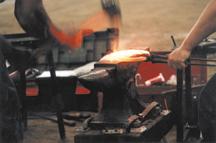| Published in the May 2000 Issue of Anvil
Magazine
The AFA Convention 2000 in Ontario, California, was represented by 2000-plus
registered attendees. Even though the numbers were down from the prior year,
the consensus was that Convention 2000 presented a wealth of knowledge in
the form of lectures from clinicians and speakers. The AFA, with the assistance
of the Western States Farriers Association and the San Diego County Farriers
Association, orchestrated a convention that elicited very favorable comments
from many of those present.
Conventioneers who were expecting typical Southern California sunny weather
instead got a taste of what happens when it does rain in California. And
it was a deluge! Fortunately, it cleared up toward the end of the convention,
and everyone did see a little of the sunshine.
The convention committee even arranged for an earthquake, just to make everyone
feel like they were getting their money's worth.
One of the lectures was presented by Jeff Rodriguez called "Running a Farrier
Business for Profit." The subject matter was geared toward those farriers
wanting to succeed, but needing financial guidance. Jeff discussed the importance
of establishing balance in the farrier's personal as well as professional
life. He talked about the common factors in the three phases of a lifetime
career. Establishing priorities and the definition of a business were other
important aspects of his presentation.
The ongoing dry dissection lab presented by Jan Young, DVM, had people standing
in line, but mercifully, the wait was only in the neighborhood of ten minutes.
The lab had tables which were set up for different subjects, such as lameness
and prevention and maintenance, using hoof, bone and leg models. The format
was a roundtable of farriers and veterinarians who shared questions and answers.
In the hands-on clinic, I was fortunate enough to work with Kirk Caudle in
making a French hunter hind shoe. The hands-on clinic is always an invaluable
part of the convention for the instructors, students and those farriers just
working together to improve mutual techniques.
Mike Savoldi delivered a couple of really interesting lectures. The first
one was entitled, "Identifying Coffin Bone Angle in Relation to the Sole."
The moisture of the true sole is uniform in depth, and trimming to the moisture
line will result in uniform sole thickness, placing the hoof capsule on a
horizontal plane. There are many angles to the sole, forming the arch of
the foot, and the coffin bone will actually model to these angles. Trimming
the foot to uniform sole thickness will put the coffin bone in a true
medial/lateral horizontal plane.
The second presentation was entitled, "Hoof Tissue Damage Based on the Plane
of the Coffin Bone." Equine body weight descends down the bone column and
the coffin bone is constantly being forced to level to the horizon. Unequal
wall lengths caused by improper trimming sets the capsule up for failure.
When the hoof capsule cannot support the load it will fail, pushing tissue
around, causing flares and prolapsed soles.
The extreme breakover roundtable moderated by Dr. Stephen O'Grady, was an
informative, in-depth discussion of breakover, which explored the biomechanics
of the normal foot. (See Gabrielle Pullen's article beginning on page 27).
Historical perspectives were offered by Gordon Haight, Reuel Darling, Jay
Sharp, Scott Simpson, Bill Miller, and C.E. Smith. They brought to the forefront
much that is ever-changing, as well as procedures, products, and methods
which have remained stable in the industry.
"Shoeing in Your Right Mind," a book written by Dr. Doug Butler, was discussed
in Dr. Butler's lecture. He is a most informative speaker. An exercise which
was included was one where Dr. Butler requested those in attendance pick
up a pencil and draw out the inner structures of the leg and foot; we were
amazed to see how their right brain worked and to see that the left brain
could be developed to complete the whole.
Dr. Hilary Clayton discussed various aspects of research in which she is
involved at the Equine Sports Medicine Department at the College of Veterinary
Medicine, Michigan State University. She pointed out that locomotion is the
most important function of the horse's body and its study, or gait analysis,
provides information for analyzing the horse's pattern of movement. It is
also important to be able to detect the presence of gait asymmetries that
might be indicative of lameness and for assessing hoof imbalances. Hilary
uses a video analysis to study the horse's movements and force analysis to
measure how the hoof pushes against the ground. She has developed techniques
for combining video and force data to evaluate the torques around the joints
and the generation and absorption of power across each joint. Her presentation
described the techniques for gathering data, the phases of the stride and
their functional significance, kinetics, joint torques and powers at the
coffin joint, and the effects of farrier modifications on limb mechanics.
In her video recording process, data is generated by digitizing videotapes,
resulting in the study of movement patterns known as kinematics. Over $40,000
was raised at the auction. The Walt Taylor Award was given to Tony Gonzales.
Baker and Blane Chapman accepted the Humanitarian Award that was awarded
posthumously to their father, Burney Chapman.
Return to the May 2000 Table of Contents
|

Erin Simmons striking for Kerry Zuest with the results shown
Below |